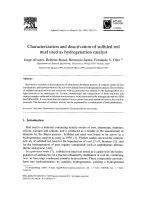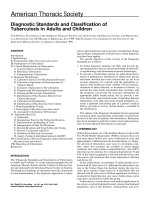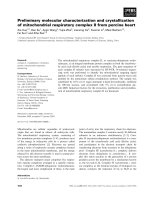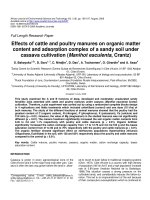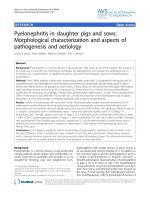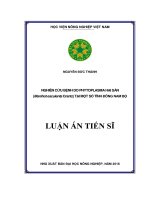Morphological characterization and classification of cassava (Manihot esculenta Crantz) in Vietnam
Bạn đang xem bản rút gọn của tài liệu. Xem và tải ngay bản đầy đủ của tài liệu tại đây (773.84 KB, 8 trang )
Morphological characterization
TAP CHI SINHand
HOC
classification
2016, 38(3):
of 344-351
cassava
DOI:
10.15625/0866-7160/v38n3.8570
MORPHOLOGICAL CHARACTERIZATION AND CLASSIFICATION
OF CASSAVA (Manihot esculenta Crantz) IN VIETNAM
Chu Duc Ha1, Le Thi Ngoc Quynh1, Nguyen Trong Hien2,
Pham Thi Ly Thu1, Le Huy Ham1, Le Tien Dung1*
1
International Laboratory for Cassava Molecular Breeding (ILCMB), Agricultural Genetics Institute
2
Root Crop Research and Development Center, Field Crops Research Institute
ABSTRACT: The aim of this study was to establish the morphological basis for the classification
of major cassava cultivars (Manihot esculenta Crantz) planted in Vietnam. Twenty typical
descriptors were observed in various specific growth stages. Four traits related to mature leaves and
two traits related to leaf veins were detected in cassava plants after the 4-month stage. At the same
time, 12 root- and stem- related descriptors were collected in cassava plants from 8 months old to
harvest. We found that two traits in the apical leaves can be observed in every growth stage. A
classification tree based on these traits was constructed with 6 essential morphological descriptors
to recognize the 7 most common cassava cultivars in Vietnam. KM 140 variety is distinguished by
purplish-red in apical leaves, while KM 98-7 can be classified with straight or linear shapes of
central leaflet. The irregular orientation of the petiole is a unique descriptor of local cultivar XVP.
In the case of SM 937-26, weak foliar scars are observed. Finally, KM 94, KM 419, and KM 98-5
varieties can be classified by the color of the stem epidermis. These morphological descriptors will
be a foundation to classify all cassava varieties planted in Vietnam.
Keywords: Manihot esculenta, cassava plant, morphology, growth stage, phenotype, descriptors
Citation: Chu Duc Ha, Le Thi Ngoc Quynh, Nguyen Trong Hien, Pham Thi Ly Thu, Le Huy Ham, Le Tien
Dung, 2016. Morphological characterization and classification of cassava (Manihot esculenta Crantz) in
Vietnam. Tap chi Sinh hoc, 38(3): 344-351. DOI: 10.15625/0866-7160/v38n3.8570.
*Corresponding author:
INTRODUCTION
Cassava (Manihot esculenta Crantz), an
annual food crop in the tropical regions, is one
of the most important crops of the
Euphorbiaceae family. It is mainly grown in
Africa, the Caribbean, and Asia [5]. Having
high concentration of carbohydrates and being
easy to grow, cassava is regarded as a
multifunctional plant, such as food, feed, and
raw materials in various industries. Thus, this
tuber crop is not only a poor man's food but also
a cash crop for millions of people living in rural
areas of Southeast Asia, including Vietnam [9].
Cassava varieties have been distinguished
from one another by morphological descriptors
observed in major organs, such as leaves, stems
and roots. Unfortunately, a number of
phenotypical
characters
can
change
significantly depending on the cultural practice
and the pressure of abiotic and/or biotic stresses
[11, 13], making germplasm characterization,
344
conservation and breeding systems more
difficult. In Vietnam, a comprehensive study of
phenotypic characterization is still lacking [7,
8]. Thus, a list of morphological descriptors has
not yet been established for the DUS
(Distinctness, Uniformity and Stability) and
VCU (Value for Cultivation and Use) trials.
Therefore, the objective of this study is to
establish a set of morphological descriptors that
are typical and specific for growth stages of
cassava plants, and to initially construct the
phenotype-based classification chart of cassava
varieties in Vietnam. This work may provide a
significant lead for further studies seeking to
establish a complete characterization of cassava
in Vietnam.
MATERIALS AND METHODS
Seven cassava varieties [10, 16], including 5
of the most cultivated varieties, 1 promising
new variety, and 1 local variety were obtained
Chu Duc Ha et al.
from the field of the Root Crop Research and
Development Center (RCRDC), Field Crops
Research Institute, located in Chuong My,
Hanoi as described in table 1.
The morphological descriptors used in this
study were based on the reference list of
morphologies selected by the International
Institute of Tropical Agriculture (IITA) [6] and
the draft guidelines for conducting tests for
distinctness, uniformity and stability, published
by the International Union for the Protection of
New Varieties of Plants (UPOV). The
experiments were conducted from October 2014
to April 2015. Observations were carried out
with 3 replicates. All photos and the
classification tree were subsequently visualized
using Adobe Illustrator.
Table 1. Seven cultivated cassava varieties in Vietnam used in this study
No
1
Name
KM 94
(KU 50/ Kasetsart 50/
MTAI16/MKUC 29-77-3)
Origin
Kasetsart/Thailand
Pedigrees
Rayong 1 ×
Rayong 90
Unknown
2
SM 937-26 (SM 937)
CIAT/Colombia
3
KM 98-5
IAS/Vietnam
4
KM 98-7 (SM17-17-12)
RFCRC/Thailand
5
KM 140
IAS/Vietnam
6
KM 419 (SVN5)
Unknown
7
XVP ("Xanh Vinh Phu")
Local variety
KM 98-1 ×
Rayong 90
SM 17-17 × CM
321-188
KM 36 × KM
98-1
BKA 900 ×
(KM 98-5 × KM
98-5)
Unknown
Year released
Released in Vietnam
in 1995 [15]
Released in Vietnam
in 1995 [15]
Unknown
Unknown
Unknown
Unknown
Unknown
CIAT: International Center for Tropical Agriculture; IAS: Institute of Agricultural Sciences for Southern
Vietnam; RFCRC: Rayong Field Crop Research Center.
RESULTS AND DISCUSSION
Typical morphological characteristics of
cassava at various development stages
Based on two standard characterization
systems released by UPOV and IITA [6], five
most vital organs - apical leave, mature leave,
petiole, stem and root - were screened to obtain
descriptors that are easy to collect in the fields.
This screening was based on the observations
conducted by CIAT and the Brazilian
Agricultural
Research
Corporation
(EMBRAPA, Brazil) and can be applied to the
world's main cassava collections [6]. In this
study,
we
found
20
morphological
characteristics in those 5 organs: 4 of those
were identified in mature leaves, while 2 and 7
descriptors were recognized in petioles and
stems, respectively. There were 5 descriptors in
roots, and 2 traits recorded in apical leaves. A
list of 20 morphological descriptors for
characterization of cassava used in this study
was established previously and shown in table
2. The scales of 20 descriptors were established
and developed based on previously described
[6, 7], while code of each descriptor was used as
mentioned in previous report [4].
It should be noted that three distinct tissues
comprise a mature cassava root. Care should be
taken to correctly separate the tissues for correct
characterization of the root pulp and root cortex
colors. The root pulp, known as "parenchyma",
is composed of xylem vessels radially
distributed in a complex of starch-containing
cells [17]. The root cortex, composed of
sclerenchyma, cortical parenchyma and phloem,
is a thin layer of cells on the outermost part of
345
Morphological characterization and classification of cassava
the root [14]. Thus, the manual removal of the
root cortex from the middle third of freshly
harvested root tuber is recommended to observe
the color of this peel layer, while a cross-section
of mature cassava root was used to obtain the
color of parenchyma tissues.
Table 2. List of typical morphological descriptors for characterization of cassava used in this study
Growth stage
After 4 months
Organ
Mature leaf
Petiole
After 8 months
346
Stem
Descriptor
CODE
Shape of central leaflet
FFAD1
Leaf color
CLAD1
Number of leaf lobes
Color of leaf vein
NLB2
CNFE1
Petiole color
CPET1
Orientation of petiole
OP2
Prominence of foliar
scars
PFS2
Color of stem exterior
CTIG1
Color of stem epidermis
CSE2
Color of stem cortex
CSC2
Growth habit of stem
GHS2
Scale
Ovoid
Elliptic
Linear
Lanceolate
Pandurate
Obovate
Light green
Dark green
Purplish green
Purplish red
3/ 5/ 7/ 9/ 11 lobes
Green
Reddish green
Red
Purple
Yellowish green
Green
Reddish green
Greenish red
Red
Purple
Semi-erect
Horizontal
Dropping
Irregular
Weak (0-3 mm)
Medium (4-8 mm)
Strong (≥8 mm)
Orange
Grayish yellow
Green
Greenish yellow
Brownish yellow
Light brown
Dark brown
Grey
Cream
Light brown
Dark brown
Orange
Purple
Light green
Dark green
Orange
Cream
Purplish
Straight
Chu Duc Ha et al.
Harvest
Stem
Level of branching
PORT1
SP2
Shape of plant
Root
Any stages
1
Apical leaf
Extent of root peduncle
LPED1
Root shape
FRTU1
External color of storage
root
CEPI1
Color of root pulp
(parenchyma)
CCHA1
Color of root cortex
(peel)
CPHE1
Color of apical leaves
CAPE1
Pubescence on apical
leaves
PAL2
Zigzag
Unbranched
Branched
Compact
Open
Umbrella
Cylindrical
Absent
Present
Conical
Conical to Cylindrical
Cylindrical
Irregular
Cream
Light brown
Dark brown
White
Cream
Light yellow
Dark yellow
Pink
White
Cream
Yellow
Pink
Purple
Light green
Dark green
Purplish green
Purple
Absent
Present
According to Boni et al., 2014; 2Encoded as abbreviation of first symbol.
To be able to characterize cassava plants in
the fields accurately, we separately arranged 20
morphology observations in 4 major growth
stages (table 2). Four months after planting, we
can observe all descriptors in the mature leaves
and petioles. From 9 months to harvest stage, the
growth habit, colors of 3 components of stem and
the prominence of the foliar scars became
distinct enough for analyzing the stem of cassava
plants. During the harvest period, 2 traits in the
stems and all traits in the commercial roots were
observable. The time point and duration of each
developmental phase depend on varietal
characteristics, environmental conditions and the
cultural practice. Apical leaf observations may be
recorded in any growth stages of plants (table 2).
Our data were compared with that of
previous studies to propose a list of descriptors
that are deemed essential and reliable in
phenotypical characterization of cassava. Afonso
recently reported an experiment to characterize
200 accessions from EMBRAPA's Cassava
Germplasm Active Bank (BAGM, Brazil) using
35 morphological and agronomic descriptors [1].
Importantly, 20 characters are found to be
important in the classification of germplasm of
manioc, eleven of those being quantitative
descriptors and nine qualitative. To evaluate and
improve the precision of the description, Antonio
found 14 stable and discriminating descriptors of
botanical and agronomical characteristics,
including 5 used in this study, to characterize the
280 cassava accessions in BAGM [3]. A number
of those traits related to the mature leave, stem,
347
Morphological characterization and classification of cassava
or the root - such as length/width of the leaf lobe,
plant height, easiness of root periderm removal,
respectively - were altered drastically under
various environmental conditions [2, 11, 12, 13].
In the effort to characterize a total of 159
traditional varieties in Côte d'Ivoire, 14 important
characteristics of leave, stem, tuberous root, and
other organs were reported [4].
All 20 of the morphological descriptors
used in this study are typical and representative
of the 4 growth stages. They are also specific
and do not change significantly under
environment variations.
Construction of a classification chart of
major cassava cultivars in Vietnam
Figure 1. Morphology-based characterization chart of cassava varieties in Vietnam
PAL: Pubescence on apical leaves; CAPE: Color of apical leaves; FFAD: Shape of central leaflet; OP:
Orientation of petiole; PFS: Prominence of foliar scars; CSE: Color of stem epidermis.
348
Chu Duc Ha et al.
To classify the most cultivated cassava
varieties in Vietnam, we constructed a
characterization chart based on phenotypical
observations. In this study, we used 6 most
discriminating descriptors as the nodes in a
chart characterizing 7 cassava varieties in
Vietnam, including (i) pubescence on apical
leaves (PAL), (ii) color of apical leaves
(CAPE), (iii) shape of central leaflet (FFAD),
(iv) orientation of petiole (OP), (v) prominence
of foliar scars (PFS), and (vi) color of stem
epidermis (CSE). In this proposed chart, we
minimized the scale of color descriptors to
reduce the errors of color observations in the
field, as caused by different light conditions
and/or photography techniques. For example,
the color of apical leaves might be recorded as 2
contrasting colors: green gradient (including
light/dark/purplish-green) and purple. Together,
the characterization chart was built as figure 1.
used [18]. Thus, the classification chart must be
more
detailed
to
adapt
to
further
characterization of cassava germplasm.
As a result, 7 cassava varieties in Vietnam
were recognized individually by using the 6
descriptors mentioned above. Firstly, KM 140
was classified initially by the purplish-red color
recorded in the CAPE at every growth stage. In
the case of the 6 varieties sharing the green
gradient of apical leaves, the FFAD was used to
distinguish the KM 98-7 variety, whose central
leaflet is almost linear. Next, XVP, a local
variety, can be characterized by the irregular
orientation of its petiole. SM 937-26 was then
observed as following the typical medium foliar
scar (commonly 4-8 mm). Finally, 3 remaining
cassava varieties, KM 94, KM 98-5 and KM
419 were classified by different colors of stem
epidermis. The stem epidermis of KM 94 and
KM 98-5 were light brown and cream,
respectively, with the epidermis of KM 419
being orange. All cases of different observations
in other varieties are mentioned on the left side
of the chart.
Acknowledgements: This study was a part of
the training “On-the-job research capacity
building for sustainable agriculture in
developing countries” funded by the Japan
Ministry of Agriculture, Forestry and Fisheries
(MAFF) and managed by the United Nations
University Institute of Advance Studies (UNUIAS). The authors would like to thank Dr.
Manabu Ishitani (CIAT) for his contribution as
a technical consultant. Research in DTL group
at AGI was funded by the National Foundation
for Science and Technology Development of
Vietnam under the grant number 106-NN.022013.46. Equipment at the International
Laboratory for Cassava Molecular Breeding
(ILCMB) was funded by the CGIAR-RTB
program to CIAT and its partners in 2014. The
authors wish to thank Stephanie K. Dalquist
() for improving English usage in
this manuscript.
The phenotypic characterization of 7
cassava varieties in Vietnam using 6
morphological descriptors by the classification
chart is straightforward. To further compare
cassava varieties - not only those most
cultivated in Vietnam but also popular in other
parts of Asia (Thailand, Cambodia, China, etc) additional phenotypical descriptors should be
CONCLUSION
Twenty typical morphological descriptors
specific to four growth stages were used to
characterize cassava varieties in Vietnam. Initial
results on the classification of seven cassava
varieties in Vietnam indicated that KM 140
variety can be identified by the purplish-red
color in apical leaves at every stage of growth,
while KM 98-7 variety can be classified by the
linear shape of central leaflet. Irregular petiole
orientation is a descriptor unique to the local
cultivar, XVP. In the case of SM 937-26,
observation of weak foliar scars was recorded.
Finally, KM 94, KM 419, and KM 98-5
varieties can be classified by the color of stem
epidermis.
REFERENCES
1. Afonso S. D., Ledo C. A., Moreire R. F.,
Silva S., Leal V. D., Conceicao A. L., 2014.
Selection of descriptors in a morphological
characteristics considered in cassava
accessions by means of multivariate
techniques. Journal of Agriculture and
Veterinary Science, 7(1): 13-20.
349
Morphological characterization and classification of cassava
2. Alves A. C., Setter T. L., 2004. Response of
cassava leaf area expansion to water deficit:
Cell proliferation, cell expansion and
delayed development. Annual of Botany,
94(4): 605-613.
3. Antonio V. P., Roland V., Cosme D. C.,
1992. Selection of botanical and
agronomical
descriptors
for
the
characterization of cassava (Manihot
esculenta Crantz.) germplasm. Brazil
Journal of Genetics, 15(1): 115-124.
4. Boni N., Okoma M. P., Kouakou A. M.,
Dibi K. E. B., Zohouri G. P., Essis B. S.,
Dansi A. A., 2012. Morphological
characterization of cassava (Manihot
esculenta Crantz.) accessions collected in
the Centre-west, South-west and West of
Cote d'Ivoire. Greener Journal of
Agricultural Sciences, 4(6): 220-231.
5. Ceballos H., Iglesias C. A., Pérez J. C.,
Dixon A. G. O., 2004. Cassava breeding:
opportunities
and
challenges.
Plant
molecular biology, 56(4): 503-516.
6. Fukuda W. M. G, Guevara C. L., Kawuki
R., and Ferguson M. E., 2010. Selected
morphological and agronomic descriptors
for the characterization of cassava.
International
Institute
of
Tropical
Agriculture, Research Nourish Africa, 28
pp.
7. Chu Duc Ha, Le Thi Ngoc Quynh, Nguyen
Trong Hien, Le Huy Ham, Le Tien Dung,
2015. Identification of morphological
descriptors for characterization of cassava
(Manihot esculenta Crantz.) in Vietnam
based on KM 94 variety. Tap chi Sinh hoc,
37(1): 31-38 (in Vietnamese).
8. Hang T. T. N., Nga T. H., Hoa T. T., Ha P.
N., 2012. Results of evaluation of cassava
germplasm in Vietnam: Period 2010-2011.
Scientific Reports. Vietnam Plant Resources
Center (in Vietnamese), 6 pp.
9. Howeler R. H., 2014. Sustainable soil and
Crop management of Cassava in Asia. A
reference manual. CIAT Publication No.
389, ISBN 978-958-694-125-9.
10. Howeler R. H., Kawano K., Ceballos H.,
350
2006. CIAT initiatives on cassava
improvement in ASIA. In: souvenir 14th
triennial symposium of the international
society for tropical root crops. Central
Tuber
Crops
Research
Institute,
Trivandrum, India: 25 - 31.
11. Kawano K., Fukuda W. M. G., Cenpukdee
U., 1987. Genetic and environmental effects
on dry matter content of cassava root. Crop
Science, 27(1): 69-74.
12. Lenis J. I., Calle F., Jaramillo G., Perez J.
C., Ceballos H., Cock J. H., 2006. Leaf
retention and cassava productivity. Field
Crops Research, 95(2-3): 126-134.
13. Olasantan F. O., Ezumah H. C., Lucas E.
O., 1997. Response of cassava and maize to
fertilizer application, and a comparison of
the factors affecting their growth during
intercropping. Nutrient Cycling in Agro
ecosystems, 46(3): 215-223.
14. O'Hair S. K., (1990). Tropical Root and
Tuber Crops. In: J. Janick and J.E. Simon
(eds.), Advances in new crops. Timber
Press, Portland, 424-428
15. Quyen N. T., Kim H., Tuan V. V., Kwano
K., 1995. New cassava varieties with high
starch. Conference on Agricultural Science
and Technology in Southern Vietnam,
MARD, 26pp (in Vietnamese).
16. Robinson J., Srinivasan C. S., 2013. Casestudies on the impact of germplasm
collection, conservation, characterization
and evaluation (GCCCE) in the CGIAR.
The Consultative Group for International
Agricultural Research Publications, 41pp.
17. Wheatley C. C., Chuzel G., 1993. Cassava:
the nature of tuber and use as a raw
material. In: Macrae R., Robinson R. K.,
Sadler M. J., (eds) Encyclopedia of food
science food technology, and nutrition.
Academic press, San Diego, California,
734-743.
18. Wongtiem P., 2013. Characterization of
cassava germplasm in Thailand. Report of
the Rayong Field Crops Research Center.
Department of Agriculture (in Thai
language).
Chu Duc Ha et al.
NHẬN DẠNG HÌNH THÁI VÀ BƯỚC ĐẦU PHÂN LOẠI MỘT SỐ GIỐNG SẮN
(Manihot esculenta Crantz) Ở VIỆT NAM
Chu Đức Hà1, Lê Thị Ngọc Quỳnh1, Nguyễn Trọng Hiển2, Phạm Thị Lý Thu1,
Lê Huy Hàm1, Lê Tiến Dũng1
1
Phòng Thí nghiệm Quốc tế Chọn giống Phân tử Sắn, Viện Di truyền Nông nghiệp
2
Trung tâm Nghiên cứu và Phát triển Cây có củ, Viện Cây lương thực
TÓM TẮT
Nghiên cứu này được tiến hành để thiết lập cơ sở dữ liệu về hình thái cây sắn (Manihot esculenta Crantz)
ở Việt Nam. Kết quả đã xác định được 20 đặc điểm hình thái đặc trưng, có thể thu thập theo từng giai đoạn.
Trong đó, có 4 chỉ tiêu liên quan đến lá trưởng thành, 2 chỉ tiêu trên cuống lá có thể quan sát ở giai đoạn từ 4
tháng sau khi trồng. trong khi có 12 đặc điểm hình thái trên thân, củ ở giai đoạn sau 8 tháng và giai đoạn thu
hoạch. Hai chỉ tiêu trên lá đỉnh có thể quan sát ở bất cứ giai đoạn sinh trưởng nào của cây sắn. Từ đó, chúng
tôi đã bước đầu xây dựng được cây phân loại cho 7 giống sắn phổ biến tại Việt Nam dựa trên 6 đặc điểm hình
thái đặc trưng. Giống sắn KM 140 có lá đỉnh màu đỏ tía, trong khi KM 98-7 có thể phân biệt bằng hình thái
thùy trung tâm dạng thẳng hẹp. Cuống lá gắn lên thân không có quy luật là đặc điểm đặc thù của giống địa
phương XVP, trong khi lồi sẹo lá của SM 937-26 có kích thước trung bình. Ba giống KM 419, KM 98-5, và
KM 94 phân biệt nhau ở màu sắc lớp bên trong vỏ thân. Nghiên cứu này sẽ được tiếp tục phát triển nhằm
nhận dạng đẩy đủ hình thái của các giống sắn Việt Nam.
Từ khóa: Manihot esculenta, cây sắn, giai đoạn sinh trưởng, hình thái, nhận dạng.
Received 27 July 2016, accepted 20 September 2016
351
